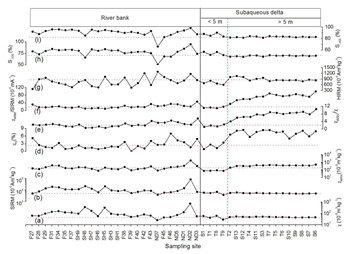Magnetic properties of sediments of the Red River: Effect of sorting on the source-to-sink pathway and its implications for environmental reconstruction
We conducted a mineral magnetic study of river bank and subaqueous delta sediments from the Red River, in order to examine the role of sedimentary sorting on the variation of sedimentary magnetic properties from source to sink. The magnetic mineralogy mainly consists of magnetite and hematite. Bulk sediment particle-size variations have a strong influence on magnetic properties, with the frequently used magnetic parameters χfd%, χARM, χARM/χ, and χARM/SIRM exhibiting positive correlations with the <4 mm fraction, while S-ratios are negatively correlated with this fraction. Compared with river bank sediments and shallow shoreface (<5 m water depth) sediments, sediments from the deeper (>5 m water depth) part of the subaqueous delta have lower v and SIRM values, a finer ferrimagnetic grain-size and higher proportions of hematite, consistent with selective loss of coarse ferrimagnetic grains on the source-to-sink pathway. We suggest that variations in magnetic properties in response to particle-size compositions and therefore depositional environment changes should be carefully addressed when magnetic proxies such as vARM/SIRM are used in the study of coastal and marine environmental changes (e.g., sea-level change). In such cases, the combined use of magnetic properties and geochemical indicators, such as Al/Ti ratio, may provide better results for paleoenvironmental reconstruction.
Figure 1. The red rectangle in Figure 1b indicates the (c) inset map, in which the sampling sites in the subaqueous delta are shown.
Figure 3. Spatial variation of magnetic properties of the river bank and subaqueous sediments. The fluvial samples are arranged in order from upstream down to the coast. The subaqueous delta samples are grouped into shoreface (water depth <5 m) and prodelta (water depth >5 m) zones. The red lines depict the mean values either for the (d–f) river bank or the (a–c and g–i) prodelta sediments. (a and b) The river bank sediments have relatively high χ and SIRM values, suggesting higher ferrimagnetic mineral concentrations. Sediments from the prodelta have higher χfd%, χARM/χ, χARM/SIRM values (Figures 3d–3f), which suggests that the ferrimagnetic minerals become finer in the prodelta sediments.
List of relate publications:
-
GEOCHEMISTRY GEOPHYSICS GEOSYSTEMS ,
2016 ,
17(2)
: 270-281


